在这里,我向您介绍一个由 Arduino Nano 和 MAX 7219 4x LED 点阵面板制成的 32 频段 LED 音频频谱分析仪。包括 4 种模式,您可以使用按钮在这些模式之间循环。关机内存用于在电源重启时将所选模式保留在内存中。特别感谢“Shajeeb”,他是这个项目的原始制作者。
零件清单
Arduino Nano x 1
MAX 7219 4x LED 点阵 x 1
瞬时按钮 x 1
4.7K 欧姆电阻 x 3
100K 欧姆电阻器 x 1
10K 欧姆电阻器 x 1
1uF 电容器 x 2
3.5mm 立体声母插孔 x 2
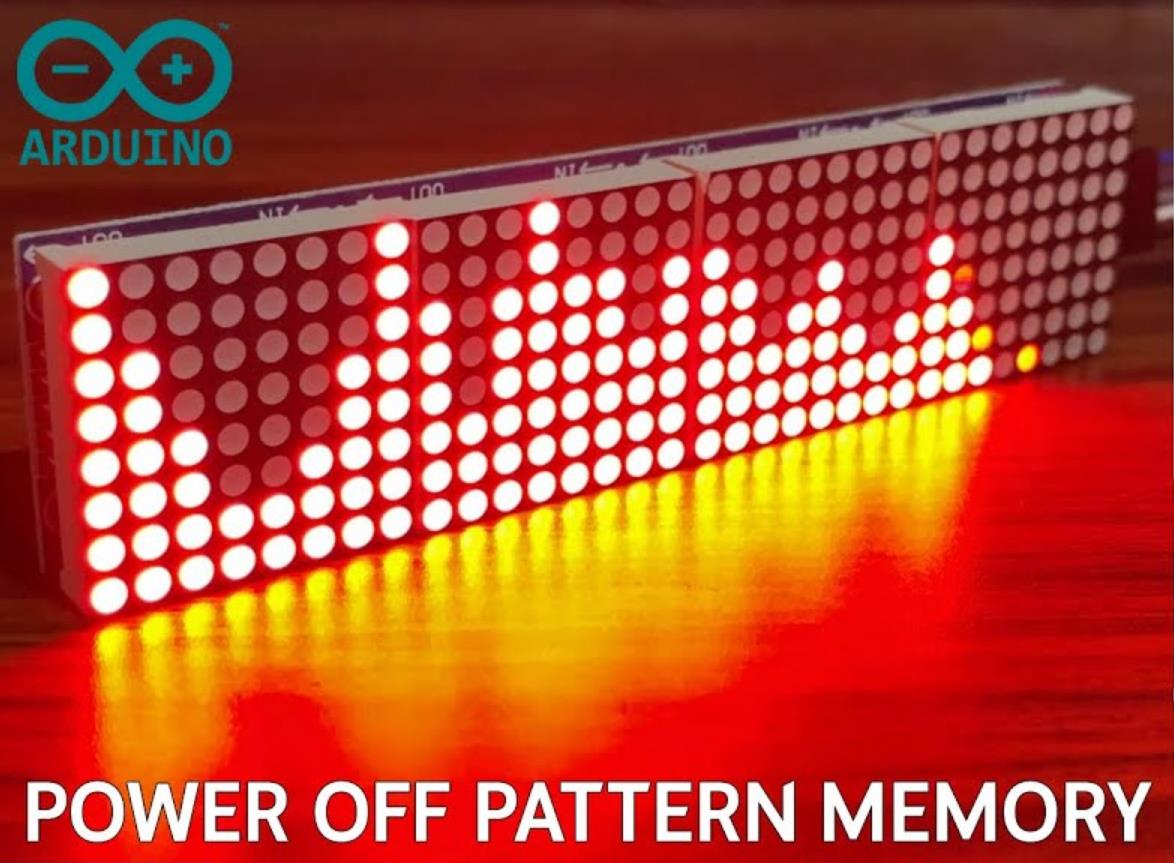
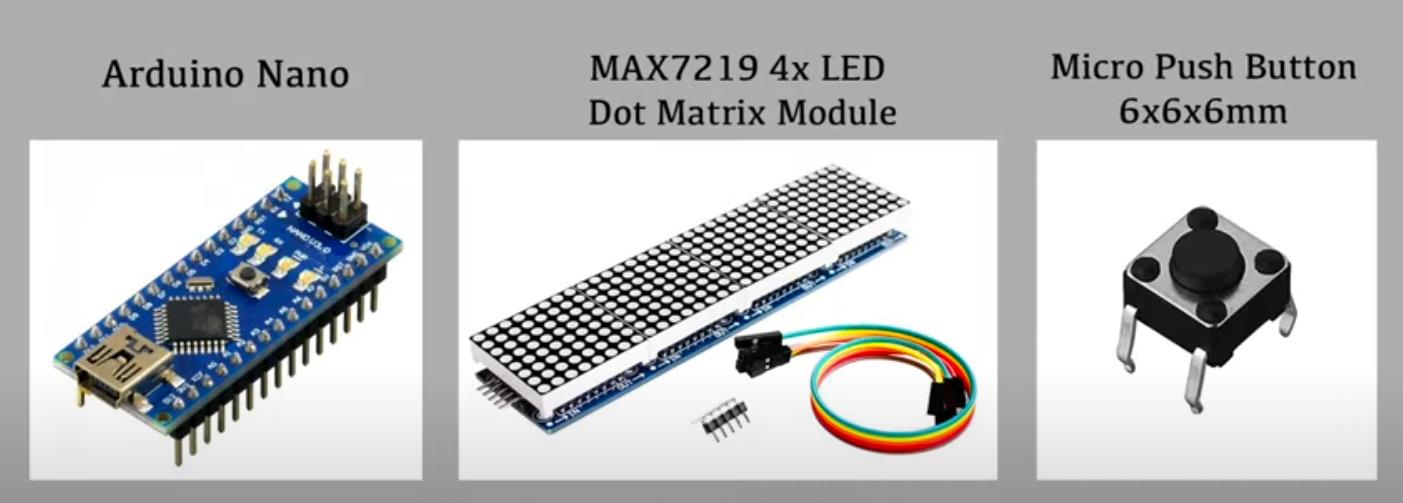
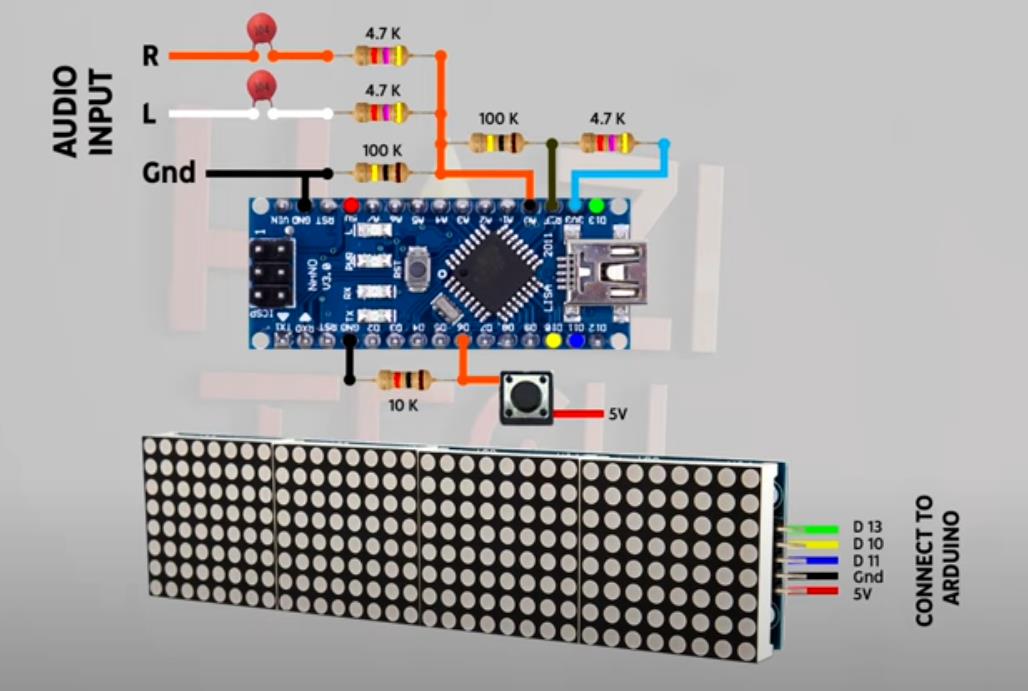
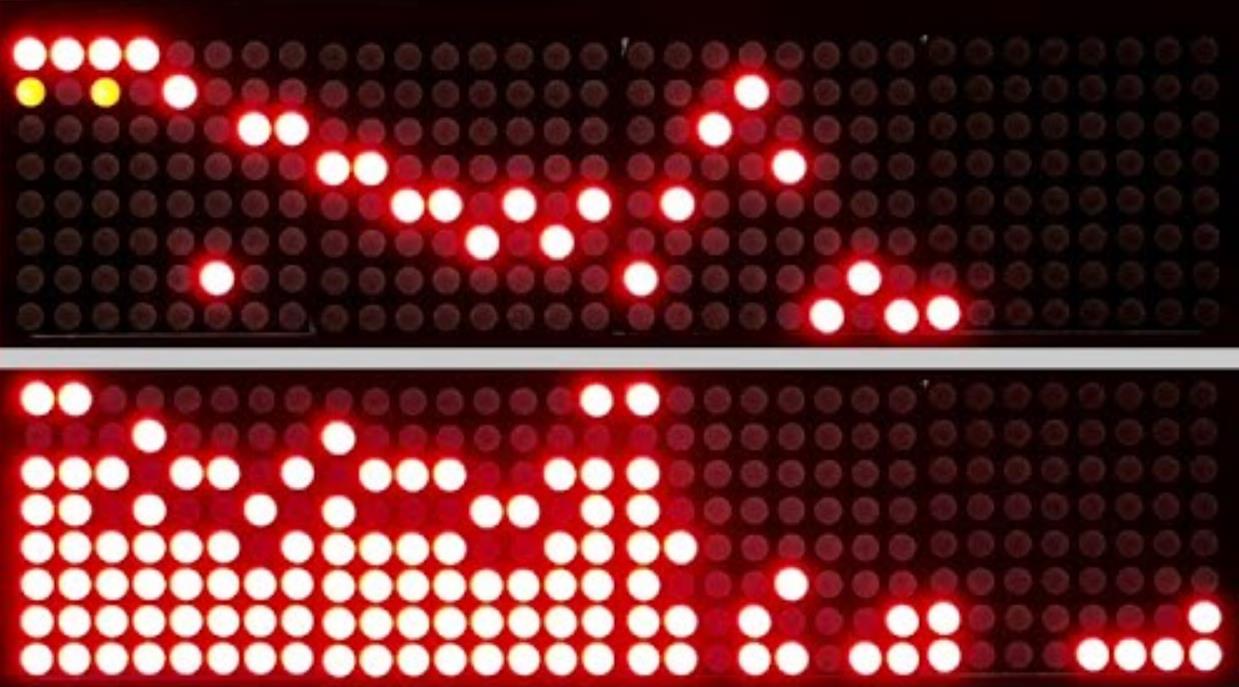
项目代码
// Copyright (c) 2019 Shajeeb TM
// HAZI TECH
// Updated by Hasitha Jayasundara
// Visit my YouTube Channel - http://www.youtube.com/c/HAZITECH?sub_confirmation=1
#include <arduinoFFT.h>
#include <MD_MAX72xx.h>
#include <SPI.h>
#include <EEPROM.h>
#define SAMPLES 64 //Must be a power of 2
#define HARDWARE_TYPE MD_MAX72XX::FC16_HW // Set display type so that MD_MAX72xx library treets it properly
#define MAX_DEVICES 4 // Total number display modules
#define CLK_PIN 13 // Clock pin to communicate with display
#define DATA_PIN 11 // Data pin to communicate with display
#define CS_PIN 10 // Control pin to communicate with display
#define xres 32 // Total number of columns in the display, must be <= SAMPLES/2
#define yres 8 // Total number of rows in the display
int audio_response = 20; // put a value between 10 and 80. Smaller the number, higher the audio response
int MY_ARRAY[]={0, 128, 192, 224, 240, 248, 252, 254, 255}; // default = standard pattern
int MY_MODE_1[]={0, 128, 192, 224, 240, 248, 252, 254, 255}; // standard pattern
int MY_MODE_2[]={0, 128, 64, 32, 16, 8, 4, 2, 1}; // only peak pattern
int MY_MODE_3[]={0, 128, 192, 160, 144, 136, 132, 130, 129}; // only peak + bottom point
int MY_MODE_4[]={0, 128, 192, 160, 208, 232, 244, 250, 253}; // one gap in the top , 3rd light onwards
double vReal[SAMPLES];
double vImag[SAMPLES];
char data_avgs[xres];
int yvalue;
int displaycolumn , displayvalue;
int peaks[xres];
const int buttonPin = 6; // the number of the pushbutton pin
int state = HIGH; // the current reading from the input pin
int previousState = LOW; // the previous reading from the input pin
int displaymode;
unsigned long lastDebounceTime = 0; // the last time the output pin was toggled
unsigned long debounceDelay = 50; // the debounce time; increase if the output flickers
MD_MAX72XX mx = MD_MAX72XX(HARDWARE_TYPE, CS_PIN, MAX_DEVICES); // display object
arduinoFFT FFT = arduinoFFT(); // FFT object
void setup() {
EEPROM.update(1,1); //(memory address, value), RUN THIS FOR THE FIRST TIME
displaymode = EEPROM.read(1);
ADCSRA = 0b11100101; // set ADC to free running mode and set pre-scalar to 32 (0xe5)
ADMUX = 0b00000000; // use pin A0 and external voltage reference
pinMode(buttonPin, INPUT);
mx.begin(); // initialize display
delay(50); // wait to get reference voltage stabilized
}
void loop() {
// ++ Sampling
for(int i=0; i<SAMPLES; i++)
{
while(!(ADCSRA & 0x10)); // wait for ADC to complete current conversion ie ADIF bit set
ADCSRA = 0b11110101 ; // clear ADIF bit so that ADC can do next operation (0xf5)
int value = ADC - 512 ; // Read from ADC and subtract DC offset caused value
vReal[i]= value/8; // Copy to bins after compressing
vImag[i] = 0;
}
// -- Sampling
// ++ FFT
FFT.Windowing(vReal, SAMPLES, FFT_WIN_TYP_HAMMING, FFT_FORWARD);
FFT.Compute(vReal, vImag, SAMPLES, FFT_FORWARD);
FFT.ComplexToMagnitude(vReal, vImag, SAMPLES);
// -- FFT
// ++ re-arrange FFT result to match with no. of columns on display ( xres )
int step = (SAMPLES/2)/xres;
int c=0;
for(int i=0; i<(SAMPLES/2); i+=step)
{
data_avgs[c] = 0;
for (int k=0 ; k< step ; k++) {
data_avgs[c] = data_avgs[c] + vReal[i+k];
}
data_avgs[c] = data_avgs[c]/step;
c++;
}
// -- re-arrange FFT result to match with no. of columns on display ( xres )
// ++ send to display according measured value
for(int i=0; i<xres; i++)
{
data_avgs[i] = constrain(data_avgs[i],0,audio_response); // set max & min values for buckets
data_avgs[i] = map(data_avgs[i], 0, audio_response, 0, yres); // remap averaged values to yres
yvalue=data_avgs[i];
peaks[i] = peaks[i]-1; // decay by one light
if (yvalue > peaks[i])
peaks[i] = yvalue ;
yvalue = peaks[i];
displayvalue=MY_ARRAY[yvalue];
displaycolumn=31-i;
mx.setColumn(displaycolumn, displayvalue); // for left to right
}
// -- send to display according measured value
displayModeChange (); // check if button pressed to change display mode
int reading = digitalRead(buttonPin);
if (reading == LOW)
{
switch (displaymode)
{
case 1: // move from mode 1 to 2
for (int i=0 ; i<=8 ; i++ ) {
MY_ARRAY[i]=MY_MODE_2[i];
}
break;
case 2: // move from mode 2 to 3
for (int i=0 ; i<=8 ; i++ ) {
MY_ARRAY[i]=MY_MODE_3[i];
}
break;
case 3: // move from mode 3 to 4
for (int i=0 ; i<=8 ; i++ ) {
MY_ARRAY[i]=MY_MODE_4[i];
}
break;
case 4: // move from mode 4 to 1
for (int i=0 ; i<=8 ; i++ ) {
MY_ARRAY[i]=MY_MODE_1[i];
}
break;
}
}
}
void displayModeChange() {
int reading = digitalRead(buttonPin);
if (reading == HIGH && previousState == LOW && millis() - lastDebounceTime > debounceDelay) // works only when pressed
{
switch (displaymode)
{
case 1: // move from mode 1 to 2
displaymode = 2;
EEPROM.update(1,2);
for (int i=0 ; i<=8 ; i++ ) {
MY_ARRAY[i]=MY_MODE_2[i];
}
break;
case 2: // move from mode 2 to 3
displaymode = 3;
EEPROM.update(1,3);
for (int i=0 ; i<=8 ; i++ ) {
MY_ARRAY[i]=MY_MODE_3[i];
}
break;
case 3: // move from mode 3 to 4
displaymode = 4;
EEPROM.update(1,4);
for (int i=0 ; i<=8 ; i++ ) {
MY_ARRAY[i]=MY_MODE_4[i];
}
break;
case 4: // move from mode 4 to 1
displaymode = 1;
EEPROM.update(1,1);
for (int i=0 ; i<=8 ; i++ ) {
MY_ARRAY[i]=MY_MODE_1[i];
}
break;
}
lastDebounceTime = millis();
}
previousState = reading;
}【Arduino 动手做】32 频段 LED 音频频谱分析仪 |Arduino Nano + MAX 7219
项目链接:https://github.com/HAZI-TECH/32-Band-LED-Audio-Spectrum-Analyzer?tab=readme-ov-file
项目作者:HAZI TECH
项目视频 :https://www.youtube.com/watch?v=QE2wv7v7q1U
项目代码:https://github.com/HAZI-TECH/32-Band-LED-Audio-Spectrum-Analyzer/tree/main/32_Band_LED_Spectrum_Analyzer
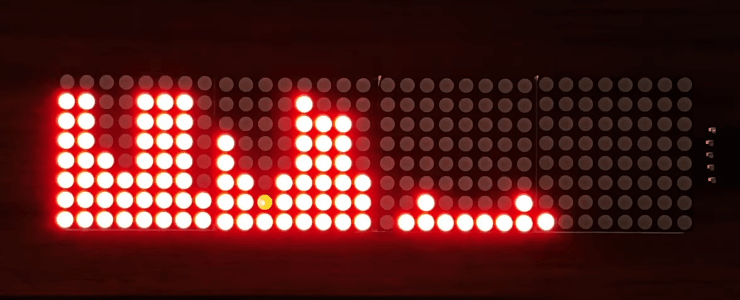

 返回首页
返回首页
 回到顶部
回到顶部


评论